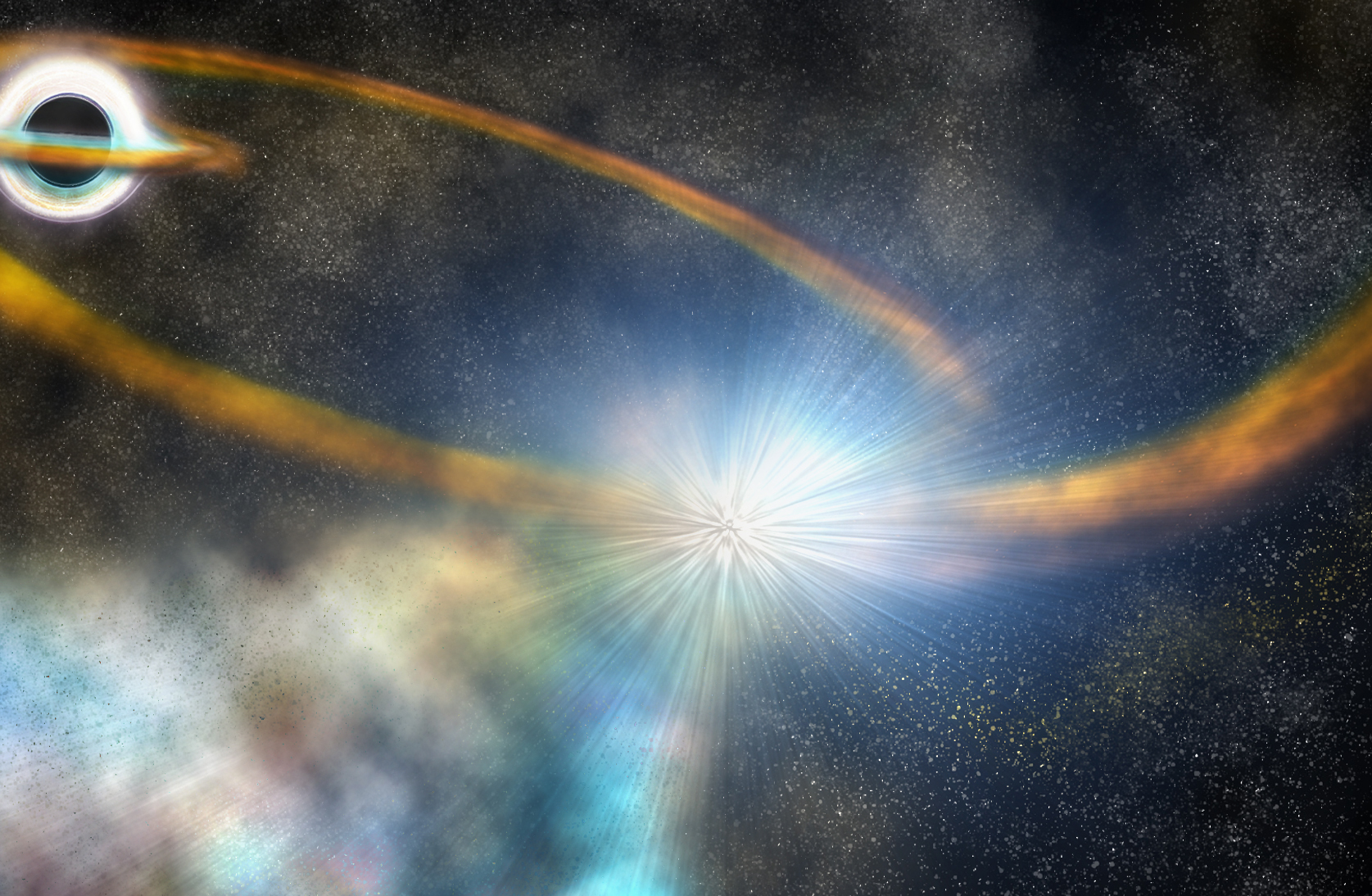Gargantuan Black Hole Shreds Star in Rare Cosmic Find
R.I.P. ASASSN-19bt. We hardly knew you.
A NASA space telescope hunting for alien planets just stumbled into a rare cosmic crime scene: a star being devoured by a monster black hole.
The discovery, made by NASA's Transiting Exoplanet Survey Satellite (TESS), provides a rare glimpse into the death throes of a star as it is torn apart by the cataclysmic gravitational forces of a supermassive black hole. The action's happening about 375 million light-years away from Earth in the direction of the constellation Volans (the fish).
The star and black hole, known together as ASASSN-19bt, is what scientists call a tidal disruption event, or TDE, in which a black hole's gravity rips gas from a star, flinging some into space. The rest forms a bright disk that gradually falls into the black hole, researchers said.
Video: Watch a Black Hold Shred the ASASSN-19bt Star!
Related: Where Do Black Holes Lead?
"Only a handful of TDEs have been discovered before they reached peak brightness, and this one was found just a few days after it started to brighten," said astronomer Thomas Holoien, of the Carnegie Institution for Science in Washington, D.C., in a statement.
Holoien said NASA's TESS, which looks for dips in the brightness of stars to identify potential planets, observed ASASSN-19bt every half-hour for months, providing a blow-by-blow account of the star's destruction.
"This makes ASASSN-19bt the new poster child for TDE research," said Holoien, a founding member of The Ohio State University's All-Sky Automated Survey for Supernovae (ASAS-SN), which made the find using TESS observations.
Breaking space news, the latest updates on rocket launches, skywatching events and more!
Holoien and colleagues used TESS data along with observations from other space telescopes and ground-based observatories to piece together the story of ASASSN-19bt's star demise for months in early 2019. They tracked it for 42 days before it reached peak brightness in March and then followed it for another 37 days as it faded, with additional observations made over the following months.
The research is detailed in the Sept. 26 edition of The Astrophysical Journal and also appears in the preprint website arXiv.org here.
Related: No Escape: Dive into a Black Hole (Infographic)
"Having so much data about ASASSN-19bt will allow us to improve our understanding of the physics at work when a star is unlucky enough to meet a black hole," said Decker French, a Carnegie astronomer and a member of the study team, in the statement.
Researchers found that ASASSN-19bt's host galaxy appears younger and dustier than those containing other TDEs found in previous studies. The team also spotted a "short blip" of cooling and fading before the TDE's temperature leveled off and began to brighten to its peak brilliance, the team reported.
The scientists were also able to measure the light from ASASSN-19bt's star to learn more about the object's composition, even as the star was ripped apart.
"It was once thought that all TDEs would look the same. But it turns out that astronomers just needed the ability to make more detailed observations of them," Ohio State astronomer Patrick Vallely, the second author on the study, said in the statement. "We have so much more to learn about how they work, which is why capturing one at such an early time and having the exquisite TESS observations was crucial."
NASA's TESS space telescope launched in April 2018 to search for alien planets around distant stars. To date, the space telescope has spotted 24 confirmed exoplanets and 993 other candidate worlds.
ASASSN-19bt is not the only nonplanet discovery from TESS. The space telescope has also observed a comet in our solar system, found more evidence for exocomets around the star Beta Pictoris 63 light-years from Earth and spotted at least six exploding stars (called supernovas) during its first few months of operation.
- Black Hole Quiz: How Well Do You Know Nature's Weirdest Creations?
- The Strangest Black Holes in the Universe
- Black Holes of the Universe in Pictures
Email Tariq Malik at tmalik@space.com or follow him @tariqjmalik. Follow us @Spacedotcom and Facebook.


Tariq is the award-winning Editor-in-Chief of Space.com and joined the team in 2001. He covers human spaceflight, as well as skywatching and entertainment. He became Space.com's Editor-in-Chief in 2019. Before joining Space.com, Tariq was a staff reporter for The Los Angeles Times covering education and city beats in La Habra, Fullerton and Huntington Beach. He's a recipient of the 2022 Harry Kolcum Award for excellence in space reporting and the 2025 Space Pioneer Award from the National Space Society. He is an Eagle Scout and Space Camp alum with journalism degrees from the USC and NYU. You can find Tariq at Space.com and as the co-host to the This Week In Space podcast on the TWiT network. To see his latest project, you can follow Tariq on Twitter @tariqjmalik.


